Find out more about The Open University's Music courses and qualifications
Interested in the technology of music? You can study that with The Open University
What is the science of music?
Music is generally thought to be an art rather than a science but what is the science behind the production of music? And can three 'tone-deaf' scientists use these principles to make musical instruments and maybe even play a tune? Let's face it, if we can master this challenge anyone can.
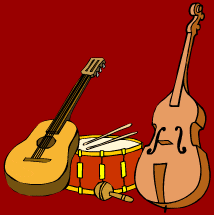
Firstly, how is sound produced?
For sound to occur you need a vibrating source and a medium, and to detect it, you need a receiver.
There are many natural vibrating sources - vocal cords, stretched strings, reeds - but to create vibration there must be a certain amount of surface tension in the vibrating body.
To reach the receiver, the vibrations need a medium of transmission such as air or water.
Vibrations from the sound source disturb molecules in the medium. The molecules move at the same rate as the sound source. As the vibration travels through the medium each molecule hits another and returns to its original position.
Regions of the medium become alternately more dense and less dense. The variation in pressure in the medium is sensed by a receiver such as the human ear or recording device and is called a sound wave.


Flow of longitudinal sound waves
Sound travels in the same way whether it is music or noise. The difference between music and noise is that musical sounds are organised into patterns that have pitch and rhythm whereas noise is just random, disorganised sounds.
A particular musical note is determined by the number of times that the musical instrument vibrates per second resulting in a sound wave. The number of times that a sound wave vibrates in a second is called its frequency.
Scientists measure the frequency of sounds in cycles per second and express the measurement in Hertz.
The human ear can detect a range of frequencies. There are frequencies that are too low to detect but can be heard by other creatures, such as whales, and there are frequencies that are too high for us to hear, such as those produced by bats when trying to avoid other objects.
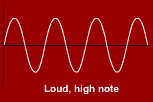
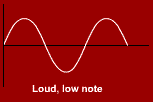
Loud high note vs loud low note diagram
So we know how higher and lower notes are produced - but how are louder and softer notes made?
Put simply, louder notes are made by bigger vibrations and softer notes are made by smaller vibrations, although the number per second, or frequency, of vibrations may remain the same. The loudness of a musical note does not necessarily change its frequency.
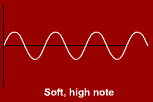
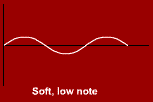
Soft high note vs soft low note diagram
If producing a note is so simple, why do the sounds made by each instrument in an orchestra or band sound so different?
The pitch is the degree of highness or lowness of a musical note. The pitch depends on how rapid the vibrations are i.e. how high the frequency is. A higher pitch has a higher frequency.

The diverse sounds made by the instruments in each section of an orchestra are due to harmonics. These are higher and quieter sounds that are mixed in with the main note. They are not heard separately but add to the tone of the sound.
Harmonic Series for a Guitar String

How are musical notes measured?
Musical notes are conventionally measured on a scale from A - G with middle C usually being used as a reference note. The scale is repeated over all 88 keys on a piano, all 6 strings of a guitar, etc.
The distance from one 'C' to the next 'C' is called an octave and in each octave the higher C has a frequency that is twice the frequency of the lower C. This shows that there is a scientific formula behind what we naturally find pleasing to our ears.

How is an instrument tuned?
To tune any two instruments, the sound waves from both of them must be at the same frequency. If the frequencies differ very slightly, the two sound waves interfere, making another sound wave that undulates in volume or 'beats'.
The beat frequency is the number of volume undulations heard per second. It is found by subtracting the lower frequency from the higher one. When two instruments are in tune, the beat frequency should be zero. This is an extremely useful tool for tuning instruments accurately by ear.
Most people can usually tell whether an instrument is in tune or not without knowing the underlying science.
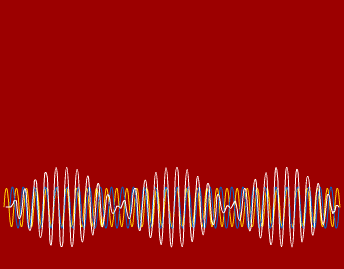
Three types of instrument
Stringed instruments
The pitch of a stringed instrument depends on the tension and the length of the string. In most stringed instruments the pitch gets higher when the player moves their hand closer to the bottom of the string making the vibrating area shorter. However, Mike's double bass depended on changing the tension of the string to obtain each note.
In many stringed instruments, the strings themselves only produce a small fraction of the sound that is heard. The rest is due to resonance from the body of the instrument vibrating in sympathy with the strings. Mike's double base had a huge box and a long string which gave it a very low pitch.
Wind instruments
These instruments work by using vibrating columns of air that amplify an initial sound. In all wind instruments, the length of the column of air determines the general pitch of the instrument. That is why the panpipes played by Ellen used bamboo tubes cut to different lengths to produce various notes.
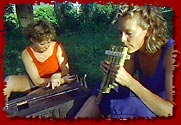 In order for a column of air to vibrate, something must start it going. The small sound produced by blowing over the top of each panpipe tube is greatly amplified within the tube, in much the same way as the body of a stringed instrument amplifies the sound from the string.
In order for a column of air to vibrate, something must start it going. The small sound produced by blowing over the top of each panpipe tube is greatly amplified within the tube, in much the same way as the body of a stringed instrument amplifies the sound from the string.
Percussion instruments
The sound of a percussion instrument comes from striking two things together. They can be the simplest type of instrument because usually very few parts are needed to produce an amplified sound. Our scientists made some drums from old barrels. When struck, the skin of the drum vibrated and was then amplified by the barrel to give out a sound.
We've seen that musical notes can be explained using science. We can even predict how to make notes using scientific equations but this doesn't help scientists to become better musicians!
This article was inspired by the work of our Rough Scientists as they attempted to create music as part of the Rough Science Cariacou series.
Weblinks
The Open University is not responsible for the content of external websites.
Math and Music - from the ThinkQuest Library of Entries site.
Energy in the Air: Sounds from the Orchestra - from the ThinkQuest Library of Entries site.
Sound Waves and Music - from The Physics Classroom site.
The Soundry - an educational website about sound.
Books
Making Gourd Musical Instruments: Over 60 String, Wind & Percussion Instruments and How to Play Them by Summit, Ginger and Jim Widess, published by Sterling Publishing.





Rate and Review
Rate this article
Review this article
Log into OpenLearn to leave reviews and join in the conversation.
Article reviews